



Cleopatra and the Peasant
oil on canvas • 97.8 x 127cm
In his masterpiece, Eugène Delacroix finds inspiration in William Shakespeare’s The Tragedy of Antony and Cleopatra, and uses this prototype to depict Act IV, Scene II. The motivations of the characters in Shakespeare’s play are parallel to the motivations of the two figures in Delacroix’s Cleopatra and the Peasant. Not only does the play influence Delacroix’s artistic style, but it shapes the painting itself.
When viewing Delacroix’s Cleopatra and the Peasant, the eye instantly falls upon the beautiful, white face of the queen. Her pristine skin illuminates the chamber in which she sits and her jewelry sparkles brilliantly. Luxurious jewels adorn her right arm, her neck and her crown, reinforcing the contrast with her pale flesh as well as giving away her royal status. Delacroix immediately bestows upon her an almost immortal persona with her radiance and extensive signs of wealth.
A closer look at the peasant’s load reveals the image of a snake nested in the basket of fig-leaves and fruit, raising her head between the man’s muscular right arm and his spotted pelt. The snake’s writhing form seems to be the only moving object in the painting and together with its green and yellow scales make it the painting’s most realistic element. Once the snake’s presence is noted, the painting has new significance. It becomes evident that Cleopatra’s face is turned towards the basket of figs and her solemn facial expression is probably influenced by the presence of the snake. Nevertheless, the peasant’s smile now looks somehow inviting and it creates the impression that he is offering the basket of figs to Cleopatra.
 Eugène Delacroix
Eugène Delacroix